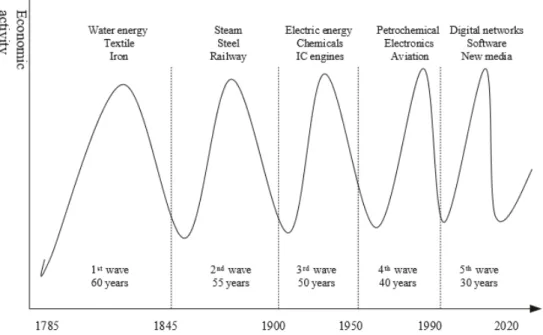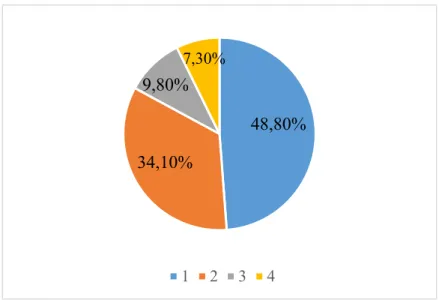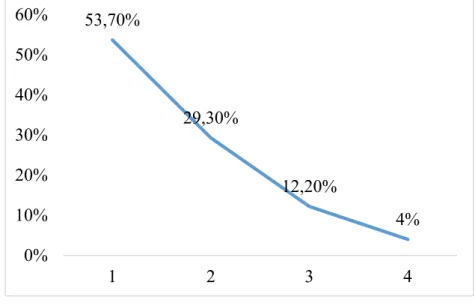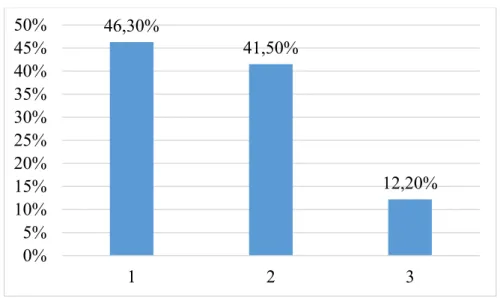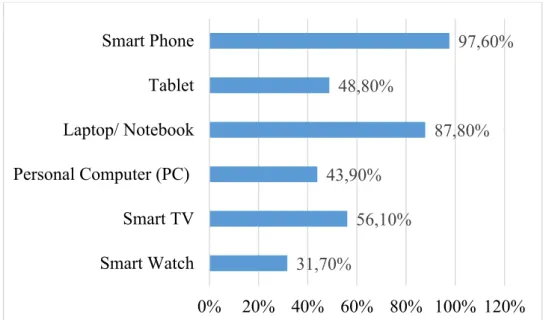Usage and Knowledge of Technological Advances in a Multi-Cultural Country:
The Level of Digitalisation in the UAE, Dubai
SOMAYEH KARIMAN
PHDCANDIDATE
UNIVERSITY OF MISKOLC email: somy2012kariman@yahoo.com
SUMMARY
The evolution of significant technological discoveries and the appearance of constantly expanding information technology have pushed mankind from the industrial era into the information and digital era. Nowadays, digitalization has become an extensive global phenomenon and the main driving force in this era of mankind. In this research, I would like to investigate and analyse digital knowledge among society. The target for my observation_ for which I used a digital survey_is the digitalisation of Dubai: a city with constant economic growth and a steady influx of foreign workers.
Keywords:Digitalization, Digital Knowledge, Dubai Journal of Economic Literature (JEL) codes: D83; M14; O3 DOI: http://doi.org/10.18096/TMP.2021.02.05
I NTRODUCTION
According to Tihinen et al (2016), digitalization has become known as one of the major trends that will change society and business in both the near and long term future. The impact of digitalization is expected to be extensive, and it has been compared to the industrial revolution (Degryse 2016; Tihinen et al. 2016). According to Henriette et al. 2015, digitalization is defined as the ability to turn existing products or services into digital variants, and thus offer advantages over tangible products. Nowadays a digital revolution is taking place in our lives, which is often called the third industrial revolution, the
“information age” (Brown and Marsden 2013;
Moghaddam 2014). Digitalization refers to the large amounts of data, increasing (algorithm-driven) analytical and processing capabilities, easy access globally, and virtual communication (Bankewitz et al. 2016). Therefore, the growth of digitalization is likely to impact our society, organizations, banking industry, and businesses which could change the
organization's strategy and structure. Consequently, organizations and society need to react to these changes to remain sustainable among other competitive. Based on this definition I can say that the era of digitalization changes the way of our working, life, and business. This means changes at several levels, including the following (Parviainen et al. 2017):
- Process level: Adaptation of new digital tools could decrease our manual steps;
- Organization level: Offering new services could improve and develop the organizational
services;
- Business level: Could change the roles and value in ecosystems;
- Society level: develop social structures such as type of work, and decision making.
L ITERATURE R EVIEW
Today’s environment is highly related to technological capabilities and digitalization.
Today’s societal characteristics have been highly influenced by the industrial revolutions which occurred during the last three centuries. Revolutions have occurred throughout history when a new technology caused a deep change in economic systems and social structures (Schwab 2016). From the first industrial revolution, which happened in the 1760s, technology has developed and adapted to change from the old ones. The second revolution was in the late 19th and early 20th century, which was a time for developing electricity and starting mass production. According to Jovanović et al.
(2018), the 1960s brought computers which shaped the third industrial revolution and this is called the
digital revolution. Finally, based on the previous digital revolution, the current, and fourth industrial revolution is happening today, managed by artificial intelligence, machine learning and the Internet of Things (Schwab 2016).
In Figure 1, I would like to present the waves of innovation suggested by Schumpeter. He argued that each wave of innovation does not last equally and that their length is shortened due to the rapid development of new technologies (The Economist 1999; Jakšić et al. 2018a). Currently, we are living in the 5th wave of innovation and digitalization, where digital solutions are becoming the leading impetus of change (Jovanović et al. 2018).
Source: Levi Jakšić et al. (2018)
Figure 1. Schumpeter’s long waves of innovation Digitization in society is transforming the
techno-economic environment and socio- institutional operations through digital communications and applications. Unlike other technological innovations, digitization builds on the evolution of network access technologies such as mobile, and fixed broadband networks, or semiconductor technologies such as computers, laptops, and tablets as an electronic application for social networks, and delivery of data. On the other
technologies such as iPhone and iPad and highly of the individualized activities, what these technologies make it possible for them. Generation "i" says that this generation was born into the world of high technologies, and is characterized by electronic communication for their inquiries in society.
Modern digital resources make it possible to meet individual needs very easily (Tomyuk et al. 2020).
According to Ustyuzhanin et al. (2018), in the individual’s life, digital technologies have already
developing the individual experience concerning the advantages of digitalization as well.
Digital Knowledge
People are trying to seek information to reduce their uncertainty in the social and work environment (Huber and Daft 1987). For example, members could seek information directly from their colleagues in the organization (Morrison 2002;
Palazzolo 2005). On the other hand, many factors are influenced in learning technology and digitalization such as culture, and financial conditions. For instance, Hofstede has already investigated the role of national culture on technology adoption related to uncertainty avoidance. He believed that high uncertainty avoidance cultures have more solutions to the new technology since these solutions are generally more predictable than human solutions. Thus, a high uncertainty avoidance culture is likely to invest more in technology and digitalization (Hofstede 2001). Also, developing knowledge concerning technological devices is defined as a gap between those who have access to digital technologies and those who do not.
Consequently, in my research, I would like to investigate digital knowledge among society in the UAE (Dubai). The UAE has become a modern country with a high level of technology and digitalization which, encourages me to carry out my research there.
U NITED A RAB E MIRATES
(D UBAI )
The United Arab Emirates (UAE) is located in the Middle East and it consists of seven parts. It is bordered by Qatar, Saudi Arabia, Oman, and finally with the Persian Gulf on the north. Abu Dhabi is the main capital and Dubai is called the capital of economics in UAE. Dubai has become a metropolitan city with a diversity of cultures. The original language is Arabic, but English is well understood and extensively used for communication between other nationalities. The current population
of UAE is 9.89 million, and Dubai, with 3.38 million, has the second-highest population after Abu Dhabi in the United Arab Emirates. The UAE has become a digital country, and its’ residents are from different cultures, with origins from Arabia, Persia, Baluchistan, Africa, and the south of Asia such as India, Afghanistan, and Pakistan, according to the Dubai online website (2020) and the UAE Government portal.
M ETHODOLOGY
In my research, I use both primary and secondary data. Consequently, I chose to use an electronic questionnaire for collecting data, because questionnaires are the best way for finding the assumptions, solutions, and possible answers to the topic of the research. I targeted the community of Dubai because, I was working there, so I used the help of my ex-colleagues to spread the questionnaire, and I shared my questionnaire in several social media platforms which was used by Dubai citizens and residents. Although I aimed for a sample size of 100, 41 people filled the questionnaire. Unfortunately, due to COVID-19, lockdown conditions, and an overall lack of enthusiasm for sharing data of personal preferences, I could not succeed in collecting more data. My questionnaire is divided into three main parts.
1. Demographic Questionnaire;
2. Questionnaire on digital knowledge and demographics in Dubai: It includes 5 categories;
Information processing, communication, content creation, safety, and problem-solving;
3. General Questionnaire.
R ESULT AND D ISCUSSION
In the following analysis, I present and discuss the outcomes of the questionnaire. The opening of the questionnaire was the demographic questions category. Table 1 presents the result.
Table 1
Demographical Characteristics of Participants in this Study
N N %
Gender Male 23 56.1
Female 18 43.9
Age <=30 11 26.8
>30 30 73.2
Degree
PhD 1 2.4
Master 20 48.8
Bachelor 20 48.8
Marital Status
Married 19 46.3
Single 17 41.5
In a long-term
relationship 2 4.9
I prefer not to say 3 7.3 Source: Own Edition
The demographical characteristic’s results show that the majority of the participants were male, over the ages of 30, and have a Master’s or Bachelor degree gave the most answer.
The second main questionnaire was about digital knowledge and demographics in Dubai, and it includes 5 categories: the first category of the questionnaire (Q1) is “Information Processing”.
Figure 2 shows the outcome.
In Figure 2, the percentages shows the results to the following answers:
1. I can use different search engines to find information.
48,80%
34,10%
9,80%
7,30%
1 2 3 4
According to Figure 2, the majority of answerers have the ability to use several search engines or use more sophisticated strategies to search online which shows a very interesting result.
The second question (Q2) was “In terms of information processing category, which one of the following would describe you the best?” The
answers show that the majority of the participants (95.1%) know about online information, and more than half of them (58.5%) assess and compare the validity of the information.
The second category is related to communication. Figure 3 shows my response:
1. I actively use a wide range of communication tools (e-mail, chat, etc.).
2. I can use advanced features of several communication tools (e.g. using Skype and sharing files).
3. I can communicate with others using Skype or chat-using basic features (e.g.
SMS and voice messaging.
4. I cannot communicate with others using Skype or chat.
Source: Own edition
Figure 3. Terms of Communication Category
Based on the result, I can say that the vast majority of residents in Dubai know how to use this type of device for their communication.
As for usage of online services (Q4), 85.3% use online services to meet their needs such as digital marketing, Internet banking, and most of the rest
know (9.8%) about it, while 4 people did not know about it. I can assume that in Dubai the majority of the people use online services for their inquires both in business and private life.
As for social networking and online collaboration tools (Q5), I obtained the result in Figure 4.
53,70%
29,30%
12,20%
4%
0%
10%
20%
30%
40%
50%
60%
1 2 3 4
1. I can use advanced features of communication tools ( e.g. video conferencing or data sharing) 2. I am aware of social networking sites and online collaboration tools.
3. I pass on or share knowledge with others online (e.g. via social networking tools or in online communities).
Source: Own edition
Figure 4. Social Networking and Online Collaboration Tools According to Figure 4, I can say that
digitalization has become part of everyday life in Dubai. With this, I ended the communication category.
The third category of the questionnaire was about content creation. Table 2, presents the results.
Table 2 Content Creation
Third Category Questions 6 Percentage
I can produce simple digital content (e.g. text, tables, images, audio
files) in at least one format using digital tools 56.1%
I can produce complex, digital content in a different format 31.7%
I can produce complex, multimedia content in a different format 9.8%
I cannot produce simple digital content in at least one format using
digital tools. 2.4%
Source: Own edition
Based on Table 2, we can say that nearly everybody in the sample knows some level of content production.
Regarding editing and formatting (Q7), one- tenth of the participants (9.8%) cannot carry out
The fourth category is safety. Concerning device security, and online security awareness (Q8). 7.3 % of responses did not know about identity theft, 34.1% knew about the possibility and the basic countermeasures, 48.8% take advanced countermeasures, and 9.8% consciously adapt their
46,30%
41,50%
12,20%
0%
5%
10%
15%
20%
25%
30%
35%
40%
45%
50%
1 2 3
Table 3 Problem-Solving
Fifth Category, Question 9: Digital Problem Solving Percentage I can find support when a technical problem occurs or when using a new program 53.7%
I can solve most of the more frequent problems that arise when using digital
technologies 39%
I cannot solve digital problems at all Less than
5%
I can solve almost all problems that arise when using digital technology Less than 3
% Fifth Category, Question 10: Application of Problem-Solving Percentage I can solve technological problems by exploring the setting and options 46.3%
When confronted with a technological problem, I can use tools I know to solve it. 34.1%
When confronted with a technological problem, I do not know tools I can use to solve
it 12.2%
I am aware of new technological development 7.3%
Source: Own edition
As indicated in Table 3, the majority of the participants either can find support or can solve problems themselves. This shows that this sample of Dubai’s residents has good skills and knowledge
concerning digital problem-solving. Finally, in Figure 5, I would like to present the results regarding the possession of smart devices among society (general questionnaire).
Source: Own edition
Figure 5. Possession of Smart Devices
According to Figure 5, nearly all of the respondents possess a smartphone, most of them owns a laptop or notebook and nearly half of them have a tablet, personal computer and/or Smart TV.
Overall, I can safely assume that majority of the residents that participated in this questionnaire possess the necessary equipment to communicate with an electronic device such as a smartphone or laptop and they know a lot about technological advancements.
D ISCUSSION AND C ONCLUSION
In the era of digitalization, personal knowledge about digital tools and resources has become so paramount in individuals’ success that it warrants further research. This era of digitalization, and Smart technologies have already created a new world full of novel materiality. For instance, it has led to expanding the boundaries and possibilities of human communication. It seems likely that a society that is based on advanced technology can easily accept these challenges and adapt to new conditions.
31,70%
56,10%
43,90%
87,80%
48,80%
97,60%
0% 20% 40% 60% 80% 100% 120%
Smart Watch Smart TV Personal Computer (PC)
Laptop/ Notebook
Tablet
Smart Phone
For instance, as a multicultural society, the United Arab Emirates has a lot to offer for its residents regarding technological advancements: automated traffic systems for public transportation, highly developed digital services for solving their problems such as digital marketing or eCommerce, and efficient laws for controlling the new generation of digital media. Based on the needs of its workforce which comes from multiple nations, the UAE has to be able to provide the necessary tools for communication with their home countries. In my opinion, communication is the key to human society and digitalization has become prevalent in communication as the driving force of globalization.
The need for being able to access important data from anywhere is a focus of the early 21st century and every country is competing in the race. To the best of my knowledge, to UAE is one of the leaders
in this industrial race. That is why in this paper, I chose Dubai for my research. Also, I cannot deny that Covid-19 has already led people to use more technology than before. Therefore, the environmental condition can also be effective in the usage of technology and digitalization too. Finally, like many studies, my research also faced the limitation of data. For example, I did not explain anything regarding culture. It may be that the type of culture is very influential in learning technology and digitalization. For instance, Hofstede (1997) argued that the use of computer technology could challenge the existential inequality between higher-ups and lower-downs in power distance cultures, particularly when it is being used for communication purposes such as email. Therefore, I recommend future research considering the concept of culture for furture research in this topic.
REFERENCES
BANKEWITZ, M., ÅBERG, C., TEUCHERT, C. (2016). Digitalization and Boards of Directors:
A New Era of Corporate Governance? Business and Management Research, 5(2),58-69 doi:10.5430/bmr.v5n2p58
BROWN, I., MARSDEN, C. T. (2013). Regulating Code: Good Governance and Better Regulation in the Information Age. MIT Press. Blog. Retrieved: December 2020:
https://www.globalmediainsight.com/blog/uae-population-statistics/
DEGRYSE, C. (2016). Digitalisation of the Economy and Its Impact on Labour Markets. Working Paper 2016.02, European Trade Union Institute (ETUI). https://doi.org/10.5771/1435-2869-2016-2
DUBAI ONLINE. https://www.dubai-online.com/essential/uae-population-and-demographics/ (Retrieved:
December 2020)
HENRIETTE, E., FEKI,M. & BOUGHZALA, I. (2015). The Shape of Digital Transformation: A Systematic Literature Review, in Ninth Mediterranean Conference on Information Systems (MCIS), Samos, Greece.
HOFSTEDE, G. (1997). Cultures and Organizations, Software of the Mind: Intercultural Cooperation and Its Importance for Survival. New Jersey: McGraw-Hill.
HOFSTEDE, G. (2001). Culture's Consequences. Thousand Oaks, CA: Sage Publications.
HUBER, G.P., Daft, R.l. (1987). The Information Environment of Organization. In F. Jablin, L.Puntnam, K.H.
Roberts And L.W. Porter (Eds.), Handbook of Organizational Communication, pp.130-164. Newbury Park, CA: Sage
JOVANOVIĆ, M., JASMINA, D., AND OKANOVIĆ, M. (2018). Digitalization and Society’s Sustainable Development – Measures and Implications. Milica Jovanović et al, Digitalization and society’s sustainable development, 36(2), 905-928. Preliminary communication UDC: 502.131.1:004 https://doi.org/10.18045/zbefri.2018.2.905
LEVI JAKŠIĆ, M., MARINKOVIĆ, S., PETKOVIĆ, J., & RAKIĆEVIĆ, J. (2018). Tehnološko Preduzetništvo (Technological Entrepreneurship). Beograd: Fakultet Organizacionih nauka.
MOGHADDAM, I. A. (2014). Regulating Code: Good Governance and Better Regulation in the Information Age, Online Information Review, 38 (5), 702-703. https://doi.org/10.1108/OIR-06-2014-0147
MORRISON, E.W. (2002). Information Seeking within Organizations. Human Communication Research, 28 (2), 229-242. https://doi.org/10.1111/j.1468-2958.2002.tb00805.x
THE ECONOMIST. (1999): Catch the wave: The long cycles of industrial innovation are becoming shorter.:https://www.economist.com/node/186628, (Retrieved: March 2018)
TIHINEN, M., & KÄÄRIÄINEN, J. (2016). The Industrial Internet in Finland: On Route to Success? Espoo, Finland: VTT, VTT Technology, Retrieved: http://www.vtt.fi/inf/pdf/technology/2016/T278
TIHINEN, M., IIVARI, M., AILISTO, H., KOMI, M., KÄÄRIÄINEN, J.,& PELTOMAA, I. (2016). An exploratory method to clarify business potential in the context of industrial internet - a case study, In Hamideh, Afsarmanesh et al., (eds).Proc, Collaboration in a Hyperconnected World, 17th IFIP WG 5.5 Working Conference on Virtual Enterprises, PRO-VE 2016, Porto, Portugal, pp.469-478. Springer.
TOMYUK, O. N., DYACHKOVA, M. A., & SHUTALEVA, A. V. (2020). Issues of modeling smart personality – a human image of the digital age. Economic Consultant, 31 (3), 115–124. https://doi.org/:
10.46224/ecoc.2020.3.8
UNITED ARAB EMIRATES' GOVERNMENT PORTAL, https://u.ae/en/about-the-uae , (Retrieved: March 2021)
USTYUZHANINA, E. V., EVSUKOV, S. G. (2018). Cifrovizaciya obrazovatel'noj sredy: vozmozhnosti i ugrozy (Digitalization of the educational environment: opportunities and threats).Vestnik Rossijskogo ekonomicheskogo universiteta im. G. V. Plekhanova, 1 (97), 3–12. https://doi.org/10.21686/2413-2829-2018- 1-3-12
